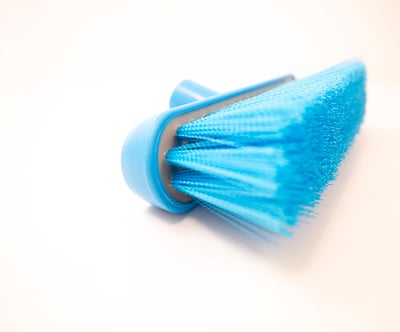It was a bleak spring day back in 1989 when I borrowed my unsuspecting mother’s Ford Fiesta, took the seats out, and headed to Northampton to pick up Hillbrush’s first ever two-part epoxy resin dispensing machine.
![]()
Hillbrush has always had a tradition of continuous investment and innovation. We had begun to develop all-plastic brushes for food processing back in 1972, and were at the forefront of what was to become a global demand for truly hygienic cleaning equipment. For some time we had been looking beyond stainless steel staples, at ways of improving how brush fibres could be fixed in the block. Plastic has many advantages, but it is slippery, and however careful you are, when making thousands of tufts sooner or later you are going to find a strand of material that will pull around the staple too easily. And at the same time we wanted to eliminate soil and moisture traps where the brush tufts were stapled to the block, which was also becoming a significant consideration. I felt that epoxy resin might be worth a try.
I tried hand mixing a resin base with many types of hardener, with expert help from the resin manufacturer, and after a good deal of experimentation, where more resin seemed to get on my hands, shoes and clothing than where it was actually intended, finally found a formula that cured hard but not brittle, and that didn’t exhibit a wicking effect where the resin crept up the filaments (to break off later). I had to know what we wanted in advance, each hardener component I tried required different amounts of base resin to cure properly. These were early days in the epoxy resin story, and fixed ratio machines were all we could find, at least at a cost we could afford. We had to know the correct ratio before we began.
I assembled the machine in the old (and by then, largely empty) hand filling department, where the Company still made a few brushes set in pitch, unconsciously passing the baton from the age-old means of gluing tufts into blocks to a 20th century one. I can still smell the heady combined smell of hot pitch and the Methylene Chloride solvent I was using.

It took another three months of experimentation to devise and perfect the means of getting the resin into the brush, ensuring the resin penetrated deep into the tuft holes without wicking up the filaments. And we also ensured that it would survive heat, cold and shocks without cracking or distortion. I spent a great deal of time with pliers pulling at fibre strands, until I was satisfied that I could not pull any of them out. At the time I was routing out plastic blocks by hand to leave a lip on the perimeter of the block to hold the runny resin, as it sank into the tuft holes and gradually cured.
Today of course we manufacture mouldings specifically for resin set brushes.
It took several months of testing to know the products would work reliably ‘in the field’.
The finished results far surpassed all products on the market in terms of tuft security and eliminating voids. Since then we have of course improved our manufacturing techniques enormously. The resin itself has been refined to ensure it is absolutely food-safe, and it now comes with an antimicrobial additive as standard, improving the food-safety aspect of our resin set brushes still further.
We put the first resin and staple set brushes in the world on sale in January 1990, and have sold them globally ever since.
Written by Peter Coward, Vice President - Operations, Hillbrush Inc.
- Our resin set brushes are made with a recessed area. The filaments are attached to the block using stainless steel staples.
- A two-part epoxy resin is then poured in over the top.
- The brushes undergo an extensive process to ensure the resin fills all areas around the base of the filaments. This means the filaments are held in not just by the staple, as in most brushes, but also by the resin.
- The resin includes an antimicrobial additive as standard.


.jpg)